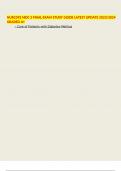NUR2392 MDC 2 FINAL EXAM STUDY GUIDE LATEST UPDATE 2023/2024
GRADED A+
– Care of Patients with Diabetes Mellitus
,● S/S: 3 Ps (polydipsia, polyphagia, polyuria), ketones, fruity breath,
Kussmaul’s resp.
o Polydipsia: increased thirst as the cells are dehydrated
and thirsty as a result of not enough fluids
o Polyphagia: increased hunger as the cells are starved
of nutrients as a result of not getting insulin and
glucose into the cells.
o Polyuria: the patient has increased urination
o Ketones: present when the body needs to get energy
from fat as the glucose cells do not work. Causes the
byproduct to be increased and ketones to present in
the urine.
o Acetone Fruity Breath: with DKA as a result of getting
increased amounts of acid out of the body
o Kussmaul's respirations: increased and deep
ventilations hen the diabetic patient tries to breathe off
excess acid in the body from increased hydrogen ions
in metabolic acidosis.
● S/S of hypoglycemia vs. hyperglycemia
Hypoglycemia - cold and Hyperglycemia - hot and dry,
clammy needs candy sugar high
● From a BG level less ● From a BG level that is
than 70 above 110
● S/S: ● S/S:
○ Sweating o Dry mouth
○ Pallor o Flushed skin
○ Irritability
, ○ Hunger o Polydipsia
○ Lack of o Polyuria
Coordination o Polyphagia
○ Fatigue o Weakness
○ Cold o Headache
● Emergency as if sugar o Blurry Vision
is not there the cells
can die.
o Rule of 15: occurs for patients in hypoglycemia. If the
patient checks their BG level and it is less than 70, the
nurse should give the patient 15 g of a carb to eat or
D50 if NPO and retest the sugar in 15 mins. If
rechecked, and BG level is still below 70, give the
patient another 15 g of carbs or D50 and recheck and
call the provider. If still too low on the tired check, give
D50 and call the provider and often RRT.
● DKA Vs HHS
DKA - Diabetic Ketoacidosis HHS- Hyperosmolar
Hyperglycemic Nonketotic
Syndrome
● Type 1 Diabetics ● Type 2 Diabetics
● From a failure to take ● From extreme
insulin or increase hyperglycemia and
insulin usage due to hyperosmolarity
stress, illness, ● If not treated, death can
confusion, or if they occur
, do not know they have ● At risk:
diabetes. ○ Older patients with
● S/S: polyuria, illness
polyphagia, polydipsia, ○ Inability to drink
ketones present in the fluids
urine, dehydration, ● The urine volume
tachycardia, orthostatic will fall and glucose
hypotension, abdominal cannot be excreted.
cramping, nausea, ● Will cause CNS
vomiting, acetone fruity dysfunction and fluid
breath, Kussmaul intake impairment
respirations, and ● NO KETONES
hyperventilation, ● S/S: extreme
confusion. dehydration,
● Labs: orthostatic
○ BG: above 300 hypertension,
○ BUN/Creatinine: confusion,
above 30 and 1.5 seizures, coma,
○ Metabolic weakness or
acidosis- low pH, paralysis,
normal or hyperreflexia,
compensated Co2, areflexia.
low HCO3 ● Labs:
○ Ketones ○ BG: above 600
present in the ○ NA level is normal
urine or low
○ Hyperosmolarity ○ K level is
● Treatment: normal or




